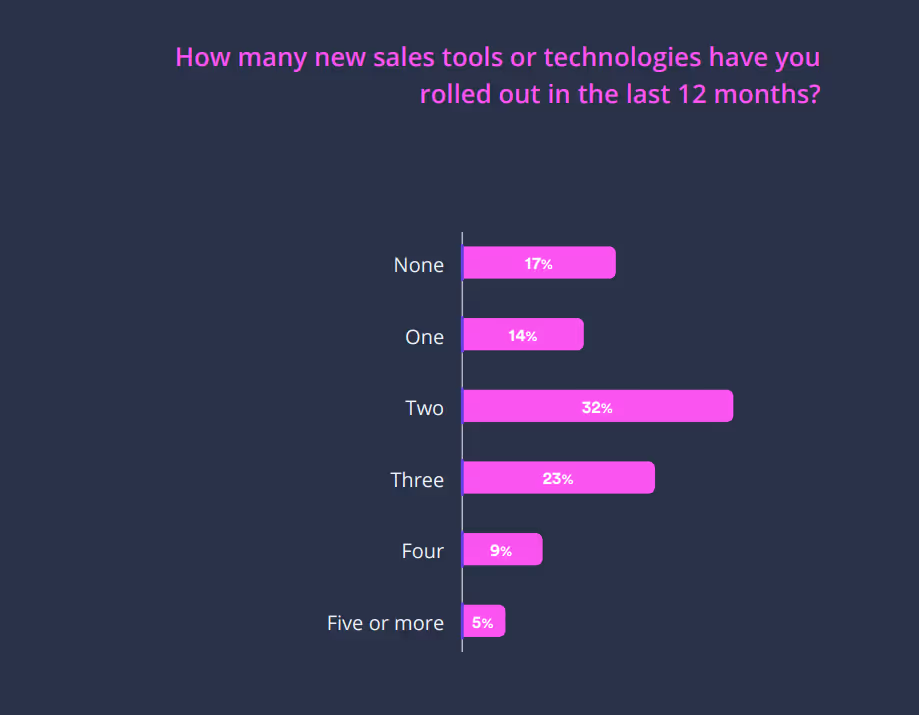Research shows that your company likely already uses a learning management system (LMS)–with 77% of U.S. companies using an LMS or similar tool for professional and skill development. An LMS can be a great tool for ensuring a standardized training procedure for your employees, but that’s not always what your team really needs.
With just-in-time training and learning, you can connect your team with the personalized training they need right when and where they’re already working. Just-in-time training can create a continuous learning environment where small, bite-sized learning experiences replace hours-long training sessions.
In this article, we break down how just-in-time learning and training can optimize your team member’s training and skill development. We’ll also be looking at how just-in-time learning can supplement the LMS you’re already using to make it more impactful, using learnings from Spekit’s “Spekit vs LMS: When to Use What?” webinar with Q4 Head of Revenue Enablement, Training and Solutions Consulting, Richard Thibault.
What is Just-in-time Training?
Just-in-time training is training where resources and materials are delivered directly in the flow of work — exactly when they’re needed. According to Spekit CEO and Co-Founder Melanie Fellay, just-in-time training’s main objective is to reduce “context switching” and ensure that employees “have the information they need right at their fingertips.”
Rather than having team members sit through hours of training where they are expected to commit large amounts of information to memory, they instead have bits of training embedded into their everyday workflow. Just-in-time training is a more hands-on form of training in which employees can learn while doing.
Just-in-time Training vs Just-in-time Learning
Just-in-time learning delivers information where and when team members need it—not just in training resources. This type of learning can be considered “active learning,” which a Harvard study found to be more impactful than sitting through lectures or longer training sessions.
Just-in-time learning and just-in-time training go hand-in-hand. Both deliver necessary, impactful resources to employees right in their flow of work, ensuring that they have the information they need when they need it the most and where they can put it into practice right away. Just-in-time training simply refers to employee training, whereas just-in-time learning is a more general term.
Examples of Just-in-time Learning
Let’s consider the just-in-time learning that Spekit users receive as an example of what just-in-time learning can look like. As a sales enablement tool, Spekit is designed to optimize sales enablement focuses, including training. The platform integrates with the tools that your sales team is already using to deliver training, collateral, and learning resources when and where they need them the most.
Spekit leverages the power of AI to surface the answers, content, and training sales reps need just in time in any tool or workflow. No more jumping between apps, no more endless hunting— just the right content at the right time.

Here’s an example of how just-in-time learning works with Spekit:
1. Your team is working in Salesforce, but they don’t remember the steps needed to qualify an opportunity.
2. Using Spekit’s browser extension, they can simply search for a Spek related to this process.
3. After reading and utilizing this Spek, a Knowledge Check will pop into their workflow for them to test their newly acquired knowledge.
Benefits of Just-in-time Training
Here are just some of the benefits of using just-in-time learning and training in your sales enablement training:
Higher retainment
Just-in-time training is a form of microlearning since it provides bite-sized bits of content to learn and utilize rather than expecting them to memorize tons of information at once. This type of learning has been shown to improve long-term retention by up to 80%.
Empowered employees
Multiple studies have found that one of the best ways to keep employees engaged and empowered is by providing them with development and training opportunities. However, not all training and skill development is created equal. More than 90% of workers say they want easy-to-understand training, 91% want personalized training, and 89% want training available anytime and anywhere.
Just-in-time training ticks all of these boxes. Nothing feels better or more empowering than being able to solve your own problem, especially when you’re learning something new. Building up confidence in employees is just as vital as ensuring they’re doing their jobs right, so having tools that encourage self-sufficiency can also work towards your retention goals.
“Especially when you’re new, you don’t want to be bugging your coworkers or your manager,” says Fellay. “When you don't know where to find something, it can really hurt your confidence.”
Boosted productivity
It’s normal to switch between tools during a workday. But when you have to stop what you’re doing to go and find an answer—or you can’t even continue because you don’t have an answer—that’s when productivity ends. Just-in-time learning platforms can provide learning right in the flow of work so teams can stay productive—without burning out.
For example, companies that use Spekit’s just-in-time learning and training have a 30% faster ramp-up time, 20% higher quota attainment, and spend 69% more time selling on average. You can also track your employees’ progress, giving you insight into their productivity.
Just-in-time Learning vs Learning with an LMS
During Spekit’s “Spekit vs LMS: When to Use What?” webinar, Thibault says that every organization can benefit from learning on an LMS and also using just-in-time learning. “At the end of the day, it’s like going to university. Learning exactly what I need to learn inside of an LMS, but as I leave, I might have a question, and I just want to go ask the university professor.”
Your school’s general courses align with an LMS, but when you have a question, you want the information fast rather than having to sit through another class to get it. Just-in-time learning is like asking your teacher.
“You have to have access to information quickly,” says Thibault, “but at the same time, you have to have that consistent training experience and learning experience for your organization.”
If you’re using an LMS, you may have difficulty accessing the information you need right away since you have a ton of content to dig through. An LMS generally has a more rigid learning path, which can work well with certain workplace training requirements. However, a salesperson will often need to access specific resources and answer specific questions—which just-in-time learning can provide more quickly and efficiently.
So when do you use which learning platform? Let’s take a look.
When to Use an LMS
You may want to use an LMS if you need to teach specific content within a particular time frame. It’s best for high-level information sales reps can take time to sit down and learn.
According to Spekit’s VP of Customer Success, Larkin Dahal, “A tool like Spekit can increase the value of your LMS because, if you’re putting a lot of stuff in your LMS that shouldn’t be there, it actually dilutes the value of the good work that is going on in that system.” What belongs in an LMS, according to Dahal, are courses with “really rigid learning paths,” like:
Certifications
An LMS works well for standardized training. If you require all of your employees in a particular role to have a certain certification, using an LMS ensures that they are all getting the same training and are properly certified.
Customer training
Sales training isn’t just training your sales team—you also need to train your customers. To get the most benefit out of your product or service, you need to set your customers up for success. Although your customers may have different use cases, you generally want to offer them the same training material to ensure they know all the ins and outs of the product. You might offer an onboarding packet or set up a training walkthrough.
Soft skills training
An LMS can be beneficial for ensuring that all your customer-facing employees are honing the soft skills that they need to succeed in their roles.
However, using a just-in-time learning tool like Spekit with your LMS can have a greater impact. Spekit delivers personalized training, so if one salesperson needs assistance with one soft skill in particular, Spekit can recommend reinforcement training on that skill.
Compliance requirements
Compliance requirements require you to adhere to a set of laws and regulations set forth by a governing or regulatory body. Since companies must follow predetermined guidelines, an LMS can help provide these uniform courses. You might use an LMS during onboarding to train your employees on diversity, equity, and inclusion (DEI) company policy or what steps to take in the case of a workplace conflict.
However, as Thibault notes, Spekit can be beneficial in the case of a policy change when you don’t necessarily need a full, new training course. You might have a legal policy in place and, using an LMS, can track attendance on a particular course and see your “level of compliance.”
“But then something changes, and you can’t force everybody into that larger session again,” he says. “You just need to update them on that change. You can do that with just-in-time learning.”
When to Use Just-in-time Training or Learning
Just-in-time learning can be used for other essential sales training, including:
Day-to-day needs
Salespeople wear many hats, and their day-to-day can vary greatly, which is why just-in-time learning helps them keep up with their role’s unique demands. Use just-in-time learning for objection handling, qualifying leads, writing sales emails, invoice processes, and other tasks your team may do each day.
“I think where just-in-time learning really thrives,” says Fellay, “is for day-to-day use, meaning the kinds of information and training that your employees need to access in their flow of work, interacting with customers, or managing their day-to-day workflows.”
Fellay references Spekit’s Salesforce integration as an example of where just-in-time training helps day-to-day work. A user can put training for their sales stages and qualification criteria right into their CRM, “where people need to access it.”
Tools and technologies
Spekit found that 69% of sales teams have introduced two or more sales tools into their tech stack in the last 12 months. To keep up with the learning and relearning of new tools and their uses, just-in-time training enables salespeople to engage in hands-on learning while utilizing the new tools.

Knowledge reinforcement
According to Gartner, sales reps forget 70% of the information they learn during sales training in just one week. With just-in-time learning, that information is consistently reinforced, making it easier to memorize and use it.
Longer internal processes
Some forms of training may only take a few hours or days to learn, but salespeople also have to learn more complicated, longer internal processes. Let’s say you implement Salesforce, which requires knowing a lot about features your team might be unfamiliar with up until now. Spekit found that the tool that sales reps tend to struggle with learning the most is Salesforce.
Fellay recommends building a training plan with in-person training that gets them excited to use the product. “That in-person conversation is much more about getting their buy-in into the why versus showing them specific workflows,” she says. She also says an LMS can be helpful with the “high level of how you’re going to be using Salesforce.”
However, when it comes to the “how do I do this specific thing,” Fellay says just-in-time learning can be more beneficial as it focuses more on the “process and the how-to.”
Just-in-time learning can break down these processes into more digestible bite-sized bits of content so sales reps can learn on the go. It can reinforce specific parts of the Salesforce process, as reps are likely to forget details if they attempt to learn everything at once.
Change management
While Spekit found that 55% of sales teams have rolled out a new sales process or methodology in the past 120 days, only 29% of sales reps would describe their business’s rollout as “excellent.” Adapting to change can be challenging, but just-in-time learning enables companies to ensure their reps receive training in real time as the rollout happens.

“I think a lot of companies struggle with change management when it comes to all the different systems that your employees are using and all the different changes happening across the business,” says Fellay. “Just-in-time learning can be a great way to reinforce and communicate that change at the time where your employee is going to encounter that change.”
Improve Your LMS With Spekit
From adhering to processes to providing more personalized learning, Spekit can make your LMS even more powerful, with users saying that they get 40% more time in their day rather than spending time searching for answers.
An LMS can help you build an individualized learning path, while just-in-time learning walks that path with them and ensures they’re getting the exact guidance they need.
For example, Spekit gives you more insight into your salespeople’s training with progress measuring and Knowledge Checks, which changes the game as less than 50% of sales leaders say they currently have insight into what training has been watched and by whom.
You’ll know you’re giving your employees exactly what they need to develop the skills that are specific to their strengths and weaknesses, filling in knowledge gaps to help them succeed.
Get started with Spekit and learn more about using an LMS and just-in-time training with Spekit’s “Spekit vs LMS: When to Use What?” webinar.







